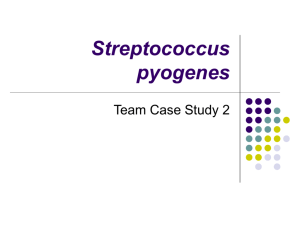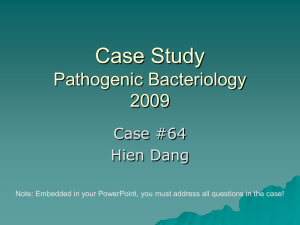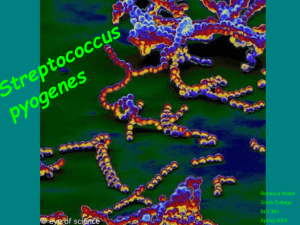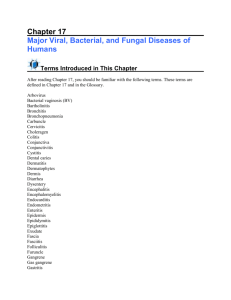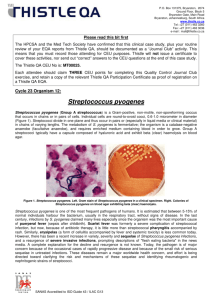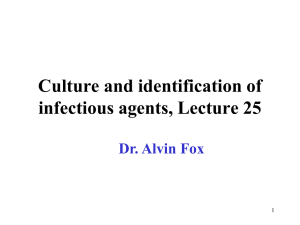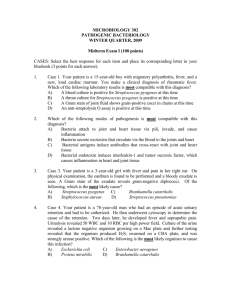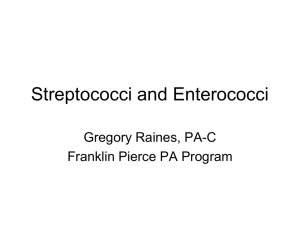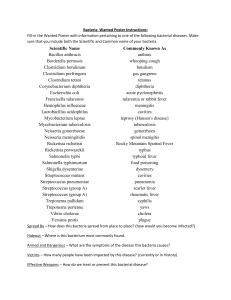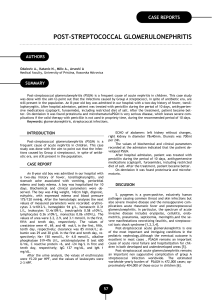Streptococcus pyogenes Fact Sheet
advertisement
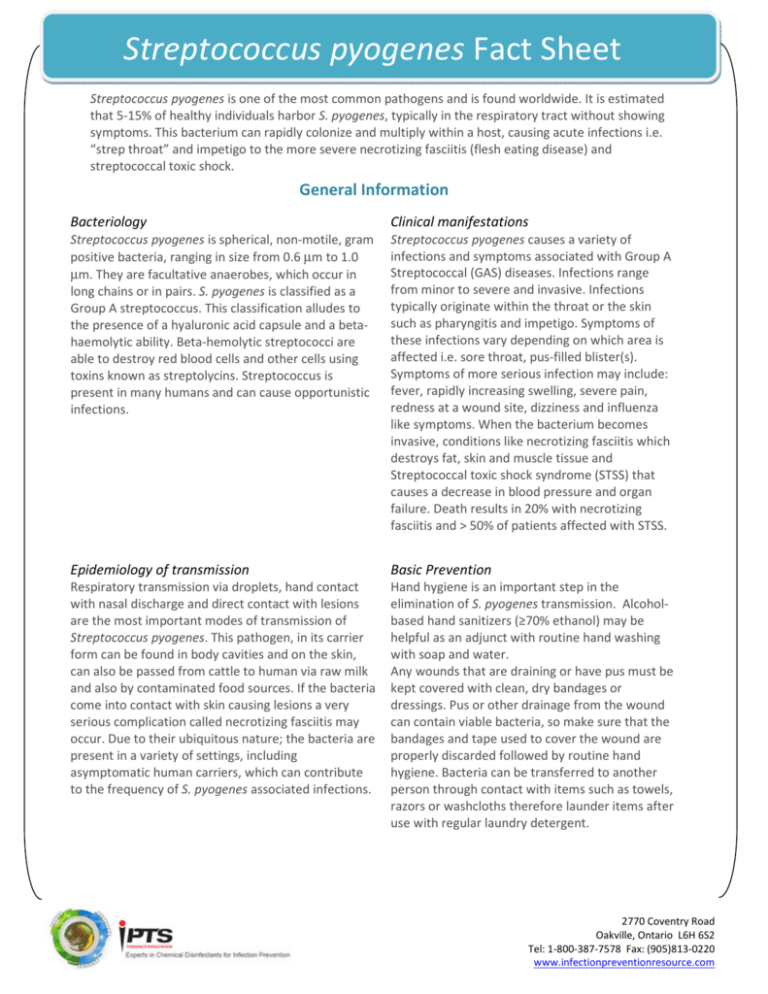
Streptococcus pyogenes Fact Sheet Streptococcus pyogenes is one of the most common pathogens and is found worldwide. It is estimated that 5-15% of healthy individuals harbor S. pyogenes, typically in the respiratory tract without showing symptoms. This bacterium can rapidly colonize and multiply within a host, causing acute infections i.e. “strep throat” and impetigo to the more severe necrotizing fasciitis (flesh eating disease) and streptococcal toxic shock. General Information Bacteriology Clinical manifestations Streptococcus pyogenes is spherical, non-motile, gram positive bacteria, ranging in size from 0.6 µm to 1.0 µm. They are facultative anaerobes, which occur in long chains or in pairs. S. pyogenes is classified as a Group A streptococcus. This classification alludes to the presence of a hyaluronic acid capsule and a betahaemolytic ability. Beta-hemolytic streptococci are able to destroy red blood cells and other cells using toxins known as streptolycins. Streptococcus is present in many humans and can cause opportunistic infections. Streptococcus pyogenes causes a variety of infections and symptoms associated with Group A Streptococcal (GAS) diseases. Infections range from minor to severe and invasive. Infections typically originate within the throat or the skin such as pharyngitis and impetigo. Symptoms of these infections vary depending on which area is affected i.e. sore throat, pus-filled blister(s). Symptoms of more serious infection may include: fever, rapidly increasing swelling, severe pain, redness at a wound site, dizziness and influenza like symptoms. When the bacterium becomes invasive, conditions like necrotizing fasciitis which destroys fat, skin and muscle tissue and Streptococcal toxic shock syndrome (STSS) that causes a decrease in blood pressure and organ failure. Death results in 20% with necrotizing fasciitis and > 50% of patients affected with STSS. Epidemiology of transmission Basic Prevention Respiratory transmission via droplets, hand contact with nasal discharge and direct contact with lesions are the most important modes of transmission of Streptococcus pyogenes. This pathogen, in its carrier form can be found in body cavities and on the skin, can also be passed from cattle to human via raw milk and also by contaminated food sources. If the bacteria come into contact with skin causing lesions a very serious complication called necrotizing fasciitis may occur. Due to their ubiquitous nature; the bacteria are present in a variety of settings, including asymptomatic human carriers, which can contribute to the frequency of S. pyogenes associated infections. Hand hygiene is an important step in the elimination of S. pyogenes transmission. Alcoholbased hand sanitizers (≥70% ethanol) may be helpful as an adjunct with routine hand washing with soap and water. Any wounds that are draining or have pus must be kept covered with clean, dry bandages or dressings. Pus or other drainage from the wound can contain viable bacteria, so make sure that the bandages and tape used to cover the wound are properly discarded followed by routine hand hygiene. Bacteria can be transferred to another person through contact with items such as towels, razors or washcloths therefore launder items after use with regular laundry detergent. 2770 Coventry Road Oakville, Ontario L6H 6S2 Tel: 1-800-387-7578 Fax: (905)813-0220 www.infectionpreventionresource.com Streptococcus pyogenes Fact Sheet Infection Prevention and Control Measures Healthcare Prevention Measures Environmental control measures In addition to Routine / Standard Precautions, Contact and Droplet Precautions should be implemented with patients who are suspected or confirmed to have S. pyogenes infection • Patients with suspected or confirmed Streptococcus infection may be placed in private rooms or cohort with other patients with the same infection. • Follow hand-hygiene guidelines: washing hands with soap and water or using AlcoholBased Hand Sanitizers (ABHS) after contact with patients with streptococcus infection • Use gowns and gloves when in contact with, or caring for patients who are symptomatic with streptococcus for all interactions that may involve contact with the patient or potentially contaminated areas in the patients environment • A mask and eye protection or face shield must be worn when within 2 meters of the patient Streptococcus pyogenes have been known to survive on surfaces from 3 days to >6 months when favourable conditions permit. Hospital-grade cleaning and disinfecting agents are sufficient for environmental cleaning in the event of Streptococcus contamination. All horizontal and frequently touched surfaces should be cleaned daily and when soiled. The healthcare organization’s terminal cleaning protocol for cleaning of the patient’s room following discharge, transfer or discontinuation of Contact and Droplet Precautions should be followed. All patient care equipment (e.g., thermometers, blood pressure cuff, pulse oximeter, etc.) should be dedicated to the use of one patient. All patient care equipment should be cleaned and disinfected as per Routine / Standard Practices before reuse with another patient or a single use device should be used and discarded in a waste receptacle after use. Toys, electronic games or personal effects should not be shared by patients. References: 1. Group A Streptococcus (GAS) disease. http://www.cdc.gov/ncidod/dbmd/diseaseinfo/groupastreptococcal_g.htm 2. Streptococcus pyogenes. http://en.wikipedia.org/wiki/Streptococcus_pyogenes 3. Impetigo. http://www.ncbi.nlm.nih.gov/pubmedhealth/PMH0001863/ 4. Necrotizing Soft Tissue Infection. http://www.ncbi.nlm.nih.gov/pubmedhealth/PMH0002415/ 5. Streptococcus pyogenes and Streptococcal disease. http://textbookofbacteriology.net/streptococcus.html 2770 Coventry Road Oakville, Ontario L6H 6S2 Tel: 1-800-387-7578 Fax: (905)813-0220 www.infectionpreventionresource.com
